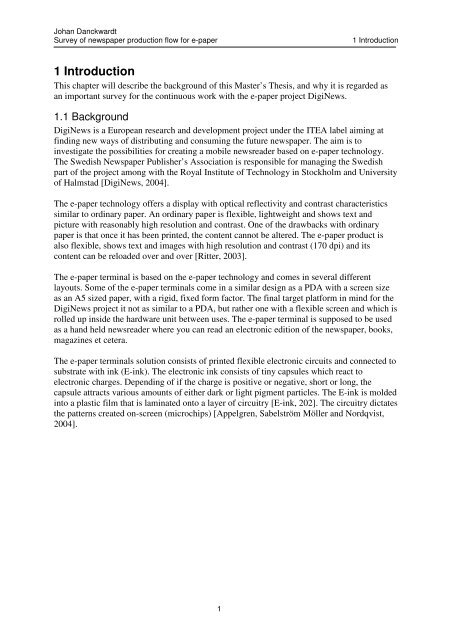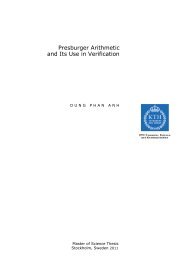Survey of Newspaper Production Flow for E-paper - Kungliga ...
Survey of Newspaper Production Flow for E-paper - Kungliga ...
Survey of Newspaper Production Flow for E-paper - Kungliga ...
Create successful ePaper yourself
Turn your PDF publications into a flip-book with our unique Google optimized e-Paper software.
Johan Danckwardt<br />
<strong>Survey</strong> <strong>of</strong> news<strong>paper</strong> production flow <strong>for</strong> e-<strong>paper</strong> 1 Introduction<br />
1 Introduction<br />
This chapter will describe the background <strong>of</strong> this Master’s Thesis, and why it is regarded as<br />
an important survey <strong>for</strong> the continuous work with the e-<strong>paper</strong> project DigiNews.<br />
1.1 Background<br />
DigiNews is a European research and development project under the ITEA label aiming at<br />
finding new ways <strong>of</strong> distributing and consuming the future news<strong>paper</strong>. The aim is to<br />
investigate the possibilities <strong>for</strong> creating a mobile newsreader based on e-<strong>paper</strong> technology.<br />
The Swedish <strong>News<strong>paper</strong></strong> Publisher’s Association is responsible <strong>for</strong> managing the Swedish<br />
part <strong>of</strong> the project among with the Royal Institute <strong>of</strong> Technology in Stockholm and University<br />
<strong>of</strong> Halmstad [DigiNews, 2004].<br />
The e-<strong>paper</strong> technology <strong>of</strong>fers a display with optical reflectivity and contrast characteristics<br />
similar to ordinary <strong>paper</strong>. An ordinary <strong>paper</strong> is flexible, lightweight and shows text and<br />
picture with reasonably high resolution and contrast. One <strong>of</strong> the drawbacks with ordinary<br />
<strong>paper</strong> is that once it has been printed, the content cannot be altered. The e-<strong>paper</strong> product is<br />
also flexible, shows text and images with high resolution and contrast (170 dpi) and its<br />
content can be reloaded over and over [Ritter, 2003].<br />
The e-<strong>paper</strong> terminal is based on the e-<strong>paper</strong> technology and comes in several different<br />
layouts. Some <strong>of</strong> the e-<strong>paper</strong> terminals come in a similar design as a PDA with a screen size<br />
as an A5 sized <strong>paper</strong>, with a rigid, fixed <strong>for</strong>m factor. The final target plat<strong>for</strong>m in mind <strong>for</strong> the<br />
DigiNews project it not as similar to a PDA, but rather one with a flexible screen and which is<br />
rolled up inside the hardware unit between uses. The e-<strong>paper</strong> terminal is supposed to be used<br />
as a hand held newsreader where you can read an electronic edition <strong>of</strong> the news<strong>paper</strong>, books,<br />
magazines et cetera.<br />
The e-<strong>paper</strong> terminals solution consists <strong>of</strong> printed flexible electronic circuits and connected to<br />
substrate with ink (E-ink). The electronic ink consists <strong>of</strong> tiny capsules which react to<br />
electronic charges. Depending <strong>of</strong> if the charge is positive or negative, short or long, the<br />
capsule attracts various amounts <strong>of</strong> either dark or light pigment particles. The E-ink is molded<br />
into a plastic film that is laminated onto a layer <strong>of</strong> circuitry [E-ink, 202]. The circuitry dictates<br />
the patterns created on-screen (microchips) [Appelgren, Sabelström Möller and Nordqvist,<br />
2004].<br />
1
















